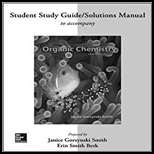
Concept explainers
(a)
Interpretation: The products formed by the reaction of alkyl bromide A with a single enantiomer of amino ester B are to be predicted.
Concept introduction: The stereochemistry of the compound is determined by prioritizing the groups attached to its stereogenic center. The groups are prioritized on the basis of
(b)
Interpretation: The product that is needed to synthesize the quinapril is to be identified.
Concept introduction: The stereochemistry of the compound is determined by prioritizing the groups attached to its stereogenic center. The groups are prioritized on the basis of atomic number of their atoms. The racemic mixture contains same amount of compounds that has S and R configuration.
Trending nowThis is a popular solution!

Chapter 7 Solutions
ORGANIC CHEMISTRY-STUDY GDE...-W/ACCESS
- Following are the steps in the industrial synthesis of glycerin. Provide structures for all intermediate compounds (AD) and describe the type of mechanism by which each is formed.arrow_forwardThe analgesic naproxen can be prepared by a stepwise reaction sequence from ester A. Using enolate alkylation in one step, what reagents are needed to convert A to naproxen? Write the structure of each intermediate. Explain why a racemic product is formed.arrow_forwardThe analgesic naproxen can be prepared by a stepwise reaction sequence from ester A. Using enolate alkylation in one step, what reagents are needed to convert A to naproxen? Draw the structure of each intermediate. Explain why a racemic product is formed.arrow_forward
- Compound A is a derivative of the carbohydrate perosamine, which is found in the antibiotic perimycin. When A is treated with acetic anhydride in methanol, a monoacyl derivative B (C9H17NO5) is obtained in 73% yield. What is the structure of compound B?arrow_forwardThe ketone shown was prepared in a three-step sequence from ethyl trifluoroacetate. The first step in the sequence involved treating ethyl trifluoroacetate with ammonia to give compound A. Compound A was in turn converted to the desired ketone by way of compound B. Fill in the missing reagents in the sequence shown, and give the structures of compounds A and B.arrow_forwardFor the following reaction scheme, identify by drawing the reagents b and d and the intermediate c that are formed in the synthesis of benzoic acid.arrow_forward
- What product is formed when a solution of A to B is treated with mild base? This reaction is the first step in the synthesis of rosuvastatin (sold as a calcium salt under the trade name Crestor), a drug used to treat patients with high cholesterol.arrow_forwardTreatment of cholesterol with mCPBA results in formation of a single epoxide A, with the stereochemistry drawn. Why isn’t the isomeric epoxide B formed to any extent?arrow_forwardIdentify the intermediates (A–C) in the following reaction sequence, which was used to prepare racemic ooxacin. One enantiomer of the product, levooxacin, is an antibiotic used to treat severe bacterial infections that have not responded to other drugs.arrow_forward
 Organic ChemistryChemistryISBN:9781305580350Author:William H. Brown, Brent L. Iverson, Eric Anslyn, Christopher S. FootePublisher:Cengage Learning
Organic ChemistryChemistryISBN:9781305580350Author:William H. Brown, Brent L. Iverson, Eric Anslyn, Christopher S. FootePublisher:Cengage Learning
